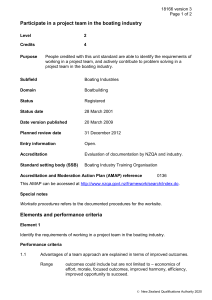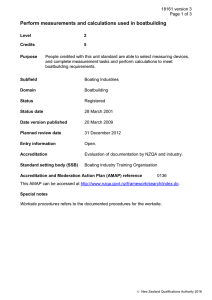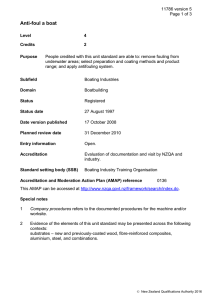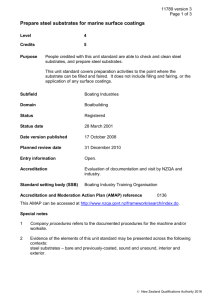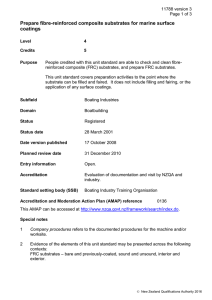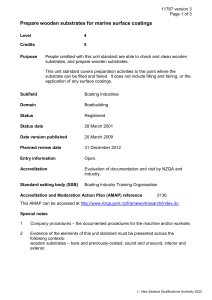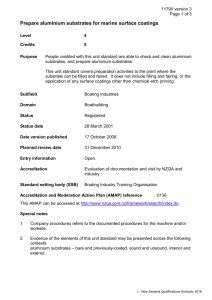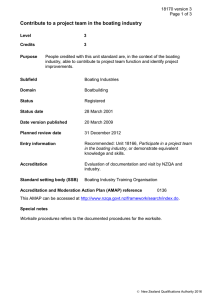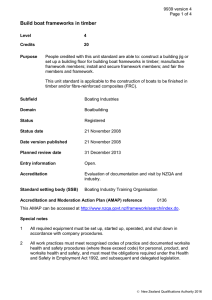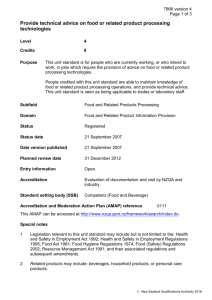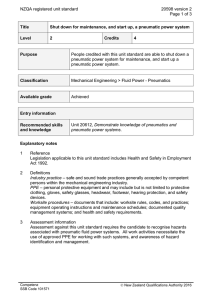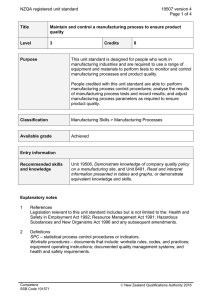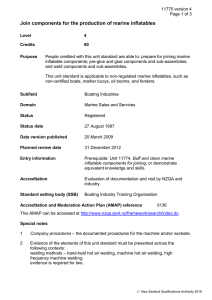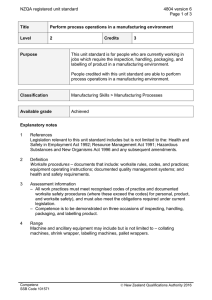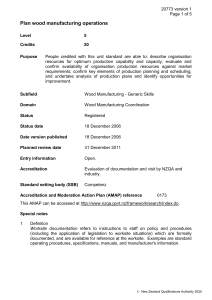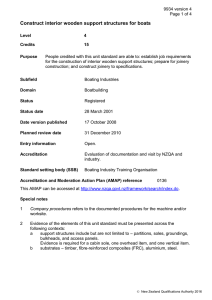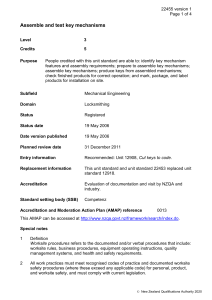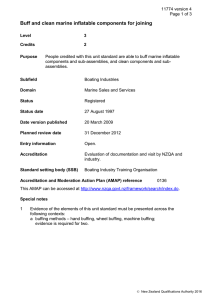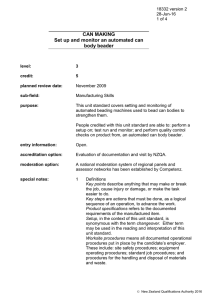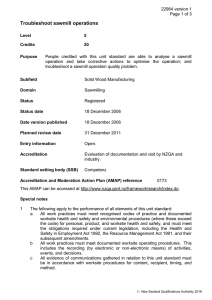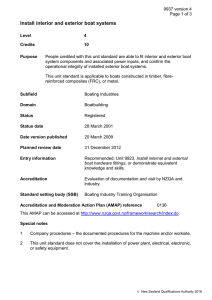Preserve and evaluate previously-submerged power plants
advertisement
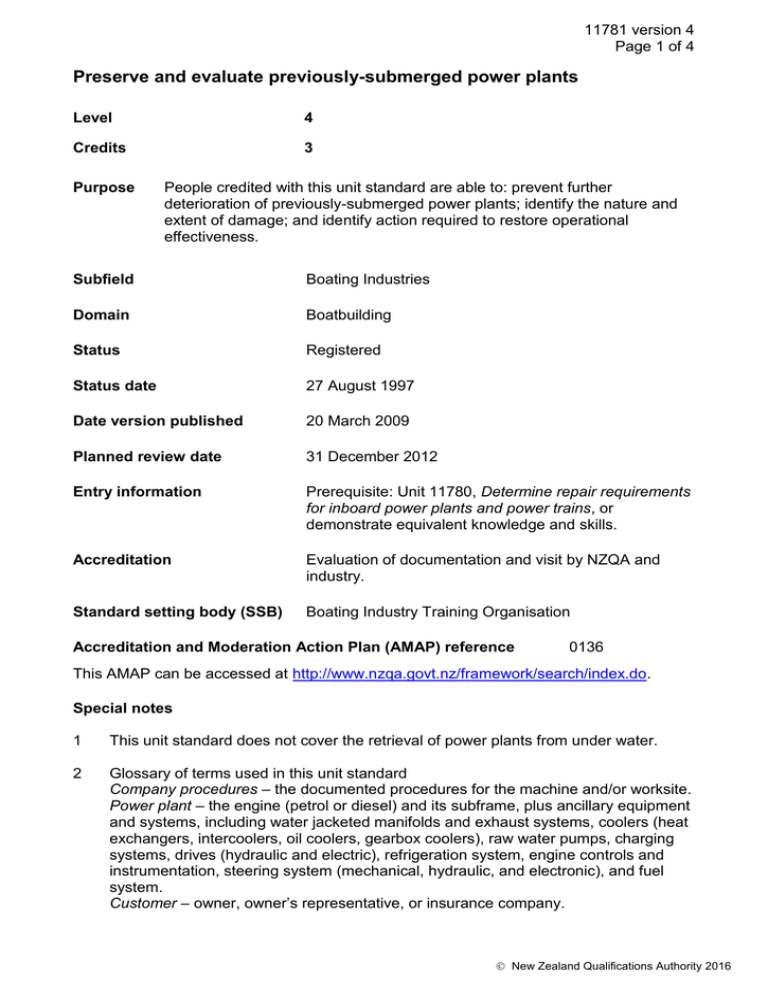
11781 version 4 Page 1 of 4 Preserve and evaluate previously-submerged power plants Level 4 Credits 3 Purpose People credited with this unit standard are able to: prevent further deterioration of previously-submerged power plants; identify the nature and extent of damage; and identify action required to restore operational effectiveness. Subfield Boating Industries Domain Boatbuilding Status Registered Status date 27 August 1997 Date version published 20 March 2009 Planned review date 31 December 2012 Entry information Prerequisite: Unit 11780, Determine repair requirements for inboard power plants and power trains, or demonstrate equivalent knowledge and skills. Accreditation Evaluation of documentation and visit by NZQA and industry. Standard setting body (SSB) Boating Industry Training Organisation Accreditation and Moderation Action Plan (AMAP) reference 0136 This AMAP can be accessed at http://www.nzqa.govt.nz/framework/search/index.do. Special notes 1 This unit standard does not cover the retrieval of power plants from under water. 2 Glossary of terms used in this unit standard Company procedures – the documented procedures for the machine and/or worksite. Power plant – the engine (petrol or diesel) and its subframe, plus ancillary equipment and systems, including water jacketed manifolds and exhaust systems, coolers (heat exchangers, intercoolers, oil coolers, gearbox coolers), raw water pumps, charging systems, drives (hydraulic and electric), refrigeration system, engine controls and instrumentation, steering system (mechanical, hydraulic, and electronic), and fuel system. Customer – owner, owner’s representative, or insurance company. New Zealand Qualifications Authority 2016 11781 version 4 Page 2 of 4 2 Evidence of the elements of this unit standard must be presented across the following contexts: power plants – inboard and outboard, diesel and petrol. 3 The following apply to the performance of all elements of this unit standard: a All required equipment must be set up, started up, operated, and shut down in accordance with company procedures. b All work practices must meet recognised codes of practice and documented worksite health and safety procedures (where these exceed code) for personal, product, and worksite health and safety, and must meet the obligations required under current legislation, including the Health and Safety in Employment Act 1992, and subsequent and delegated legislation. c All work practices must meet recognised codes of practice and documented worksite environmental procedures (where these exceed code) for personal, product, and worksite environmental matters, and must meet the obligations required under current legislation, including the Resource Management Act 1991, and subsequent and delegated legislation. d All work practices must meet documented worksite quality management requirements. These include documentation of activities, events, and decisions. e All communications made in relation to this unit standard must be made in accordance with company procedures for content, recipient, timing, and method. f All activities must comply with any policies, procedures, and requirements of the organisations involved; the ethical codes and standards of relevant professional bodies; the cultural requirements of the organisations and individuals involved; and any relevant legislative and/or regulatory requirements, which can include but are not limited to: the Fair Trading Act 1986, Consumer Guarantees Act 1993, and subsequent and delegated legislation. 4 This unit standard can be assessed on job. Elements and performance criteria Element 1 Prevent further deterioration of previously-submerged power plants. Performance criteria 1.1 Actions are taken to prevent danger to the power plant, personnel, and the environment. Range 1.2 disposal of battery fluid, refrigerant and oil; dispersal of explosive gases. Actions taken to minimise further deterioration are appropriate for the time elapsed since retrieval of the power plant from under water. Range actions – wash down, remove plugs or injectors, flood engine and gearbox with diesel fuel. New Zealand Qualifications Authority 2016 11781 version 4 Page 3 of 4 1.3 Actions are taken as soon as practicable, and in consultation with customer. Element 2 Identify the nature and extent of damage. Performance criteria 2.1 Power plant is cleaned so that inspection and measuring activities can be carried out in accordance with company and/or manufacturer’s requirements. 2.2 Inspection and measuring activities enable the extent of damage and deterioration to be quantified. Range 2.3 cylinder linings, crankshaft, rods, pistons, block and cylinder head, turbocharger, injection pump. Specialist advice regarding the integrity of ancillaries is sought in accordance with company procedures and requirements. Range ancillaries – electrical and electronic. Element 3 Identify action required to restore operational effectiveness. Range action – repair, recondition, replace. Performance criteria 3.1 Required actions are identified in conjunction with customers and/or marine surveyors. 3.2 Required actions are confirmed as being within the capability of the company to provide. Range 3.3 from own resources and/or by outwork and/or subcontracting. Required actions are costed in accordance with company procedures. Range costs – parts, machining, labour, testing, painting, meeting the costs of any relevant survey and/or regulatory requirements, transport fees, haul-out fees, storage fees. Please note Providers must be accredited by NZQA, or an inter-institutional body with delegated authority for quality assurance, before they can report credits from assessment against unit standards or deliver courses of study leading to that assessment. Industry Training Organisations must be accredited by NZQA before they can register credits from assessment against unit standards. New Zealand Qualifications Authority 2016 11781 version 4 Page 4 of 4 Accredited providers and Industry Training Organisations assessing against unit standards must engage with the moderation system that applies to those standards. Accreditation requirements and an outline of the moderation system that applies to this standard are outlined in the Accreditation and Moderation Action Plan (AMAP). The AMAP also includes useful information about special requirements for organisations wishing to develop education and training programmes, such as minimum qualifications for tutors and assessors, and special resource requirements. Comments on this unit standard Please contact the Boating Industry Training Organisation training@bia.org.nz if you wish to suggest changes to the content of this unit standard. New Zealand Qualifications Authority 2016
